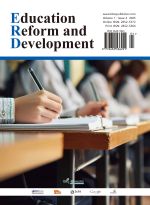Educational Applications of Collaborative Innovation under Engineering Accreditation: A Case Study of “Digital Signal Processing”
Abstract
This paper takes the case study of “Digital Signal Processing” to explore the educational applications of collaborative innovation under engineering accreditation. Digital signal processing is an emerging discipline that involves multiple disciplines and is widely applied in many fields. This course is the core foundational course of communication engineering, but it is highly theoretical, difficult to understand, and hard to master. To solve these issues, this paper explores teaching reform solutions from collaborative ability, creativity, classroom teaching methods, and educational philosophy to help students firmly grasp the fundamentals of science, mathematics, and engineering, meeting the demand for talent in the future engineering industry. The digital signal processing course group of Liaoning Technical University has carried out reforms and practices in several aspects, such as classroom teaching models, experimental teaching, and performance evaluation mechanisms. After three semesters of practice, the qualitative achievement of the course has increased by an average of 14.04%, and the quantitative achievement by 5.55%, indicating that the students’ interest in the course, their ability to apply the knowledge of the course, their ability to practice engineering, and their ability to work in a team have all improved greatly.
References
Jiang H, Xu Y, Cheng Y, 2022, Reform and Exploration on Teaching Objectives of Digital Signal Processing. Education and Teaching Forum, 8(35): 69–72.
Chen X, Yao Z, Song H, 2024, Design and Practice of Progressive and Innovative Experimental Programs for Digital Signal Processing Course. Heilongjiang Education (Research and Evaluation of Higher Education), 2024(5): 64–66.
Zhao Y, Zhao P, Lu J, 2023, Research and Practice of Mixed Teaching Models for Digital Signal Processing. China Education Society of Electronics, 2023(2): 77–78.
Dong M, Ma L, Zhu Z, et al., 2023, Student-Centered Blended Teaching Mode Exploration for Digital Signal Processing. Journal of Electrical and Electronic Education, 45(5): 144–146.
Dong T, 2022, The Current Situation of Blended Learning in Colleges and Universities and Suggestions for Improvement. Western China Quality Education, 8(22): 138–141.
Yan N, Dai C, 2023, Design of Simulation Experiment Platform for Digital Signal Processing Course Based on MATLAB. Information and Computer, 35(2): 221–223.
Huang Q, Lu G, Yang H, 2023, The Exploration and Practice of First-Class Course Construction in Digital Signal Processing. Journal of Electrical and Electronic Education, 45(1): 46–49.
Tian Z, Gao S, Chan X, 2025, Construction of Engineering Creativity and Craftsmanship Training Model for Applied Undergraduate Engineering Talents. Education Reform and Development, 7(1): 100–106.
Wang Y, Zhang X, Zhang L, 2020, Exploration and Practice of Implementation of Gradual Blended Teaching Mode by Taking “Digital Signal Processing” Course as Example. Experimental Technology and Management, 37(12): 244–249.
Ma L, Shi Y, Yuan H, 2023, Research on Hierarchical Course Teaching Design of Digital Signal Processing. Education and Teaching Forum, 25(6): 67–70.
Yu Y, Li L, Ou Y, 2023, Exploration of the Ideological and Political Elements in the Course of Digital Signal Processing. Journal of Electrical and Electronic Education, 45(5): 86–89.
Zhang T, Chen H, Liao Q, 2024, Practical Exploration of Blended Flipped Classroom—Taking the Course of “Digital Signal Processing” as an Example. The Guide of Science & Education, 2024(3): 104–106.
He F, Jiang D, Chen H, 2024, Research on the Teaching Design of Blended First-Class Courses Based on the OBE Concept—Taking Digital Signal Processing Course as an Example. University Education, 2024(6): 39–41.
Ji P, 2024, Teaching Research of Digital Signal Processing Course Based on “The Integration of Innovation and Profession.” Journal of Jilin Agricultural Science and Technology University, 33(1): 110–115.
Jiang H, Xu Y, Cheng Y, 2023, Exploring the Assessment Reform of Digital Signal Processing Courses Against the Standard of “Gold Class.” Journal of Higher Education, 9(16): 130–133.

